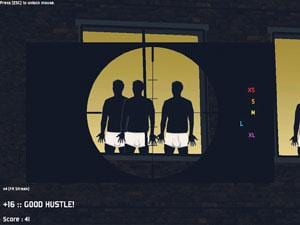
A scene from Condom Corps, a game in which players shoot condoms at gay men so they can have safe sex.
A Pride weekend art exhibit will feature video games that take queer up a level.
Titled forallgamerssake, it showcases games culture’s relationship with queerness, artists with strong queer visibility, and artists who include queer content in the games they develop.
People will be surprised by how much queer content there is in video games, says curator Jaime Woo. He notes that despite this, many view video games as immature and not welcoming of queer content.
“I’ve heard over and over that queer people playing video games think they’re alone out there,” he says.
Woo wants the video game industry to expand its idea of who a gamer can be.
“Games, when the industry started, were created by young, heterosexual white males. They created games they liked to play, which drew young, heterosexual white males. We’ve seen this industry continue to cater to young, heterosexual white males.”
But, as more people play video games, the industry is forced to change its idea of who gamers are. Hence the inclusive name — forallgamerssake.
At Pride in particular, it’s important to show queer people they’re reflected in areas they didn’t think they were reflected in, Woo says, drawing a connection between gaming and queerness.
“Games are about play — about trying on something different. Is that not what queerness is about — trying on something different?” he asks.
The show has been presented just once before, in Toronto in February.
Woo says he’s looking to bring in new artists to keep the show fresh for Ottawa Pride.
Ian Capstick, principal of the communications firm MediaStyle and chair of Ottawa’s Village committee, is hosting the show in his office.
“My ulterior motive on this one is to bring more Pride activities back to Bank St,” Capstick says, adding that he wants the parade back on the street by 2015.
The exhibit will be set up in a way that gives even people unfamiliar with gaming an opportunity to enjoy the show, Woo says.
Most of the games are video installations of big moments in game history, not obscure references that only gamers will get, he says. For instance, the role-playing game The Sims is featured.
“One thing people don’t realize about The Sims is that it was one of the first games to get women to play games because it presented gender in a way that was inclusive,” he says. “It was also one of the first to incorporate same-sex couples.”
So the show may include, say, a video clip of a same-sex marriage from The Sims.
There will also be an area where guests can play the games, some of which are less mainstream than The Sims, Woo says.
One game featured at the Toronto show is called Condom Corps, a sex-positive first-person game in which players shoots condoms at gay men so they can have safe sex. The right size condom must be shot, and players judge size based on the men’s bulges.
“First-person shooter games are usually really heteronormative, so this one is really taking this genre and flipping it on its head,” Woo says.

 Why you can trust Xtra
Why you can trust Xtra


